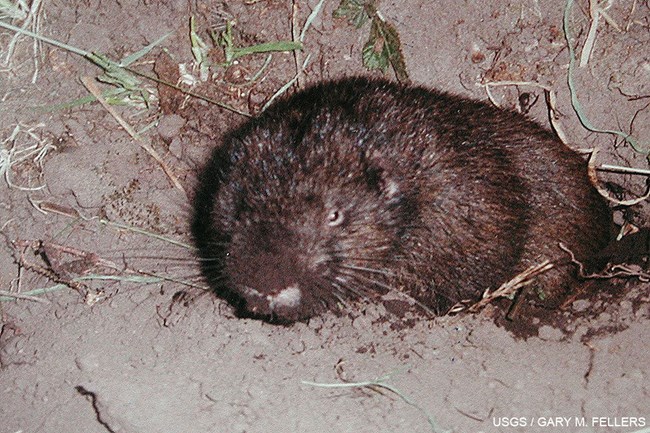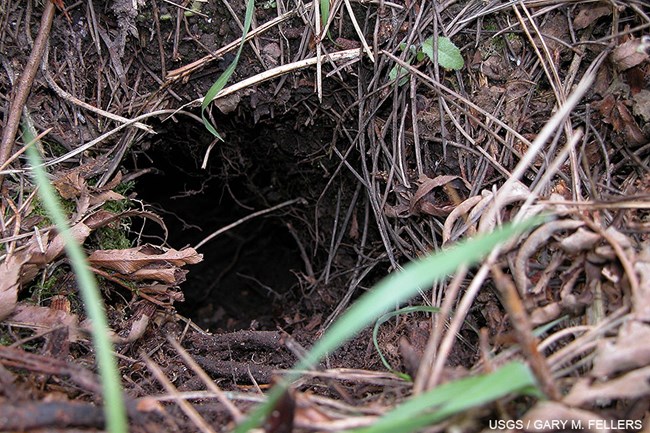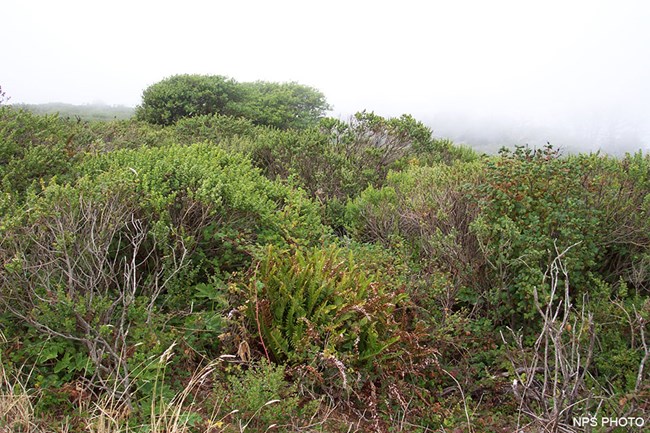
The term "beaver" often leads people to imagine a large rodent living in ponds and building dams. This is not the case with the mountain beaver (Aplodontia rufa). Mountain beavers are an unusual and primitive species of rodent. They are about the size of a muskrat, 10–12 inches (27–30 cm) long. However, they have a very short tail, less than one-half inch (1 cm) long. Mountain beavers live in underground burrows typically dug in dense thickets or in forest openings. The burrows have separate chambers for excrement, food storage and nesting. The presence of burrow openings is often the most obvious evidence of mountain beaver activity. Typically, there are multiple openings, 6–7 inches (15–18 cm) in diameter, in an area of about 150–170 square feet (14–16 square meters). Charles Camp described the burrow system in 1918 as follows: Wherever the aplodontia lives it digs extensive underground tunnels that in a populous colony form a network of passages a few inches beneath the surface of the ground. Each burrow system has many openings to the surface, but excavated dirt and rubbish is pushed out usually at only a few of these holes. 
Mountain beavers are seldom seen because they feed mostly at night. They eat a wide variety of vegetation including coyote brush, sword fern, cow parsnip, blackberries, poison oak, California nettle, foxglove, and thistle. A mountain beaver needs 1/3 of its body weight in water every day because its kidneys are simple and inefficient at conserving water. This means an adult needs to consume 1–2 cups (295–450 ml) of water daily, by drinking or from food. Because of this, mountain beavers are restricted to areas near water or with extensive summer fog along the Pacific coast. Mountain beavers range from the southwest corner of British Columbia south through western Washington and Oregon. In California, their range extends through the Sierra Nevada and barely into Nevada. Along the California coast, mountain beavers are found south to near Cape Mendocino and then in isolated coastal populations at Point Arena and Point Reyes. 
The subspecies of mountain beaver found at Point Reyes, the Point Reyes mountain beaver (Aplodontia rufa phaea), is endemic to the area—found nowhere else. It is only known to occur in western Marin County, almost entirely within Point Reyes National Seashore. Here it is found on cool, moist, north-facing slopes in moderately dense coastal scrub. This scrub vegetation typically includes coyote brush as well as sword fern, bracken fern, poison oak, California nettle, and cow parsnip, which tend to grow in the moister areas. Mountain Beaver MonitoringMountain Beavers and the 1995 Vision FireMost of the area occupied by the Point Reyes mountain beaver was regularly burned by Coast Miwok Indians who once occupied the Point Reyes peninsula. Since settlement by those of European descent in the mid-1800s, however, fires have been far less frequent and routinely suppressed. This fire control has resulted in a buildup of highly combustible fuels. The Vision Fire of October 3–12, 1995, burned 12,354 acres (5,000 ha), with 94% of the burn area within Point Reyes National Seashore. The fire consumed mostly coastal scrub, but also some Bishop Pine and Douglas fir forest, grassland, and riparian habitats. The fire burned 40% of the known range of the Point Reyes mountain beaver, including the majority of what was believed to be prime habitat. The post-fire survival rate of mountain beavers throughout the burn area was very low. Only 0.4 to 1.7% of Mountain Beavers within the burn area are believed to have survived. It is expected to take up to twenty years post-fire for full recovery of the population. In 2000, dense, groundhugging blue-blossom Ceanothus (Ceanothus thrysiflorus) appeared to make coastal scrub thickets much less suitable for mountain beavers even though the number of burrows at 11 study sites had returned to 88% of pre-fire numbers. In 2005 (10 years after the Vision Fire), the habitat appeared to be better for mountain beavers. Blue-blossom Ceanothus had diminished and vegetation more typical of northern coastal scrub, such as Coyote Brush (Baccharis pilularis) overstory with a lower layer of herbaceous vegetation, had greatly increased. But the number of Mountain Beaver burrows had declined to 52% of pre-fire numbers and there was little change in the number of sites occupied between the 2000 and 2005 surveys. With the expected successional changes in thicket structure, Mountain Beaver populations are likely to recover further, but there will probably be considerable variation in how each population stabilizes. To learn more, read:
|
Last updated: February 5, 2024
